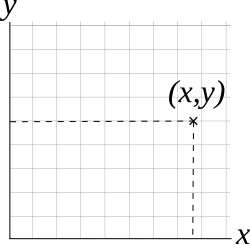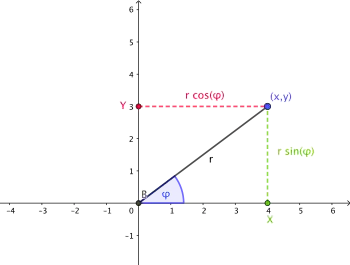Complex Numbers/From real to complex numbers
Introduction
This page about Complex Numbers/From real to complex numbers can be displayed as Wiki2Reveal slides. Single sections are regarded as slides and modifications on the slides will immediately affect the content of the slides. The following aspects of Complex Numbers/From real to complex numbers are considered in detail:
- (1) Real numbers embedded in plane of complex numbers
- (2) geometric aspects of algebraic operations in
Extension of the number range
The complex numbers extend the number range of the real numbers in such a way that the equation can be solved. The equation has no solution in . The solubility is accomplished by introducing a new imaginary number with the property . This number is referred to as imaginary unit.
Algebraic expression for complex numbers
Complex numbers can be defined in the form , where are respectively real numbers and is the imaginary unit. The identification with a vector can be used to represent complex numbers in a coordinate system (Gaußian number level).
Real part and imaginary part
The real-valued coefficients are referred to as real part or imaginary part of a complex number .
- and
Gaussian Plane
With the identification of with we can draw a complex number in plane.

Polar coordinates
The following equations show the link between exponential functions and trigonometric functions:
which results from and .
Polar coordinates

Exponential function and trigonometry
The representation with the aid of the complex e-function also means exponential representation (the polar form), the representation by means of the expression geometric representation (the polar form).
Characteristics
The set of the complex numbers forms a extension of the field of the real numbers. The set of complex numbers is a field with and has geometric and some algebraic properties that are not valid in field of real values
Fundamental theorem of algebra
The complex numbers are algebraically completed[1][2]. This theorem states that every non-constant single-variable polynomial with complex coefficients has at least one complex root.
Remark - Polynomials with real-valued coefficients
The theorem is also applicable for polynomials with real-valued coefficients, since every real number is a complex number with its imaginary part equal to zero.
Example
In the following algebraic equations with a polynomial with real-valued coefficient has no solution in but two solutions in the complex numbers.
(see [[w:en:Fundamental theorem of algebra).
Trigonometry and exponential function
In the relationship between trigonometric functions and Exponential function is defined with following equation:
see Euler's formula.
Difference: complex and real differentiation
On an open set all complex differentiable functions can also be differentiated in the real number. In calculus on the real numbers the following function
can be differentiated 2x and the thrid derivation does not exist. If we consider then is just a continuous function on but in none of the points complex differentiable.
Partial relationship between real and complex numbers
The real numbers can be considered as a subset of the complex numbers in the sense of a subset of complex numbers. In this context a real number is identified with the complex number . In the Gaussian plane, the real numbers corresponded to the points on the axis.
Complex conjugation
Changing the sign of the imaginary part of a complex number leads to the complex conjugation of a complex number . can be created by reflection of at the x axis of the plane.
Computing the Conjugation
The conjugation is a [[w:en:Involution (Mathematics)|(involutoric)] body automorphism, since it is compatible with addition and multiplication, i.e., for all
Geometric representation of conjugation
In the polar representation, the conjugated complex number has an unchanged distance to the coordinate origin (i.e. ) and has the negative angle of . The conjugation in the complex numerical plane can therefore be interpreted as the 'mirror at the real axis'. In particular, under conjugation exactly the real numbers are mapped onto themselves.
Geometric representation of conjugation
A complex number and the complex number conjugated to it

Absolute Value
The Absolute Value of a complex number is the length of its vector in the Gaussian plane or complex plane. The
calculate from their real part and imaginary part . As a length, the amount is real and not negative.
Example - Absolute Value of a complex number
Pythagorean theorem
The real part and the imaginary part of a complex number can be interpreted as the the catheti of right triangle where the length of hypotenuse is geometrically the absolute value of the complex number.
Characteristics
In the following properties apply:
- (AG/KG) The Assoziative Law and Commutative Law apply to the addition and multiplication of complex numbers.
- (DG) The Distributive Law applies.
- '(NE) O and 1 are the neutral elements of the addition resp. of the multiplication.
- (IE) For every complex number there is a complex number with .
- (IE) For each complex number different from zero exists a complex number with
Calculation - algebraic form
The algebraic properties result directly from the definition of the two links.
Addition
For the addition of two complex numbers with and
Vector Space - Visualization Addition

Subtraction
For the subtraction of two complex numbers and (see addition) applies
Multiplication
For the multiplication of two complex numbers and (see addition) applies
Division
For the division of the complex number by the complex number with the multiplication with the complex conjugate denominator for the numerator and denominator of the fraction. This results in a real valued denominator as the square of the absolute value of ):
Computation Example Addition:
Subtraction example:
Multiplication calculation example:
Computational Example Division:
Learning Activity
- Be given . Solve the equation:
- with and
- Two complex numbers are the same when they match the real part and imaginary part. This creates a equation system with two equations and the two unknowns
Complex numbers as a real vector space
The body of the complex numbers is on the one hand an upper body of , on the other hand a two-dimensional ve:en:vector space Isomorphism is also referred to as natural identification.
Base of vector space
As -vector space owns the base . In addition, is like each body also a vector space over itself, i.e. a one-dimensional -vector space with base .
Order - complex numbers
does not have (in contrast to ) no order, i.e., there is complete order relation to two complex numbers.
Links between Representations of Complex Numbers

Algebraic Structure - Polar coordinates
While the set of the real numbers can be illustrated by points on a number line, the set corresponds to as a two-dimensional real vector space .

Points - Vectors
According to the definition, the addition of complex numbers corresponds to the vector addition, the points in the number plane being identified with their [[w:en:location vector]en. The multiplication is a w:en:rotational stretching in the outer plane, which will become clearer after the introduction of the polar form (see Geogebra example).
Conversion formulae: algebraic shape into the polar shape
For is in algebraic form
For the argument can be defined with 0, but usually remains undefined. For , the argument in the interval can be used with the aid of a triArgonometric reversal function, e.
to be determined.
Conversion formulae: Polar form into algebraic form
As above, represents the real part and the imaginary part of the complex number .
Arithmetic operations in the polar form
By arithmetic operations, the following operands are to be linked to one another:
In the case of multiplication, the absolute values and are multiplied for the product and the angles and are added. For the division/fraction, the absolute values are divided and the angles are substracted.
Trigonometric Form - Multiplication
Trigonometric form - Division
Exponential Expression
Real part and imaginary part function
Be This defines the real part function and imaginary part function as a relative image as follows.
- with and
- for all
(see also Cauchy-Riemann differential equations)
Literature
- Paul Nahin: An imaginary tale. The story of . Princeton University Press, 1998.
- Reinhold Remmert: complex numbers. In D. Ebbinghaus et al. (Eds.): Numbers. Springer, 1983.
See also
- Maxima CAS/complex numbers
- Cauchy-Rieman equations
- Fundamental set of algebra
- Conjugation in ]
- Field and Isomorphism for the mapping between and .
- Complex Analysis
Sources of literature
- ↑ Dunham, William (September 1991), "Euler and the fundamental theorem of algebra" (PDF), The College Journal of Mathematics, 22 (4): 282–293, JSTOR 2686228
- ↑ Campesato, Jean-Baptiste (November 4, 2020), "14 - Zeroes of analytic functions" (PDF), MAT334H1-F – LEC0101, Complex Variables, University of Toronto, retrieved 2024-09-05
Page Information
You can display this page as Wiki2Reveal slides
Wiki2Reveal
The Wiki2Reveal slides were created for the Complex Numbers' and the Link for the Wiki2Reveal Slides was created with the link generator.
- This page is designed as a PanDocElectron-SLIDE document type.
- Source: Wikiversity https://en.wikiversity.org/wiki/Complex%20Numbers/From%20real%20to%20complex%20numbers
- see Wiki2Reveal for the functionality of Wiki2Reveal.
Translation and Version Control
This page was translated based on the following Wikiversity source page and uses the concept of Translation and Version Control for a transparent language fork in a Wikiversity: